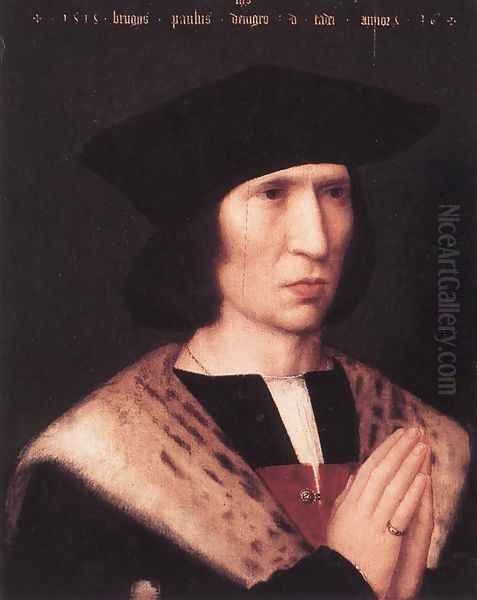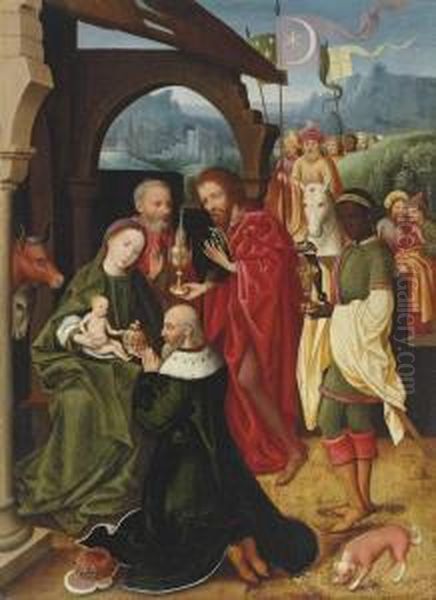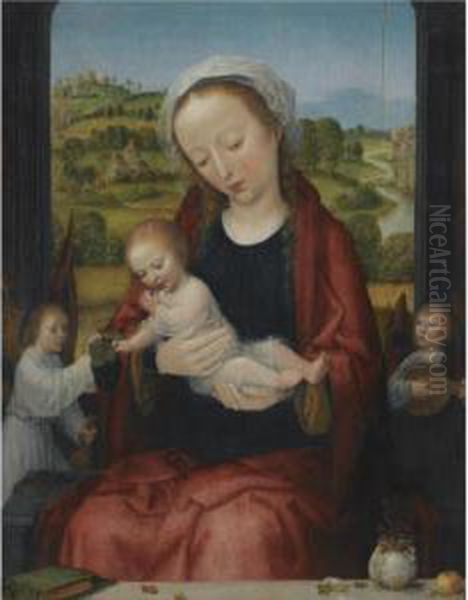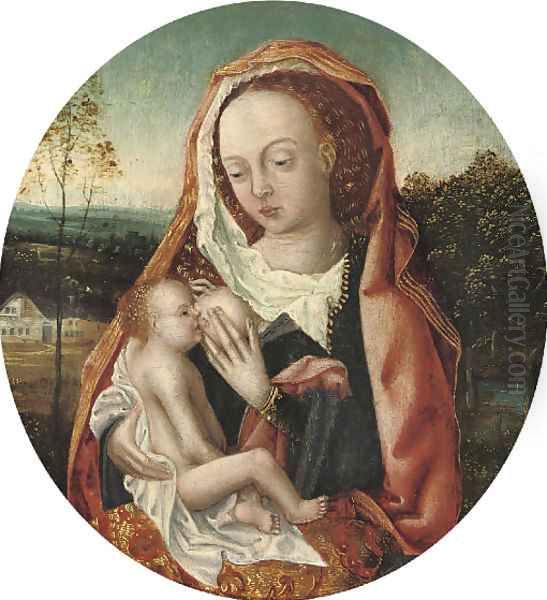Adriaen Isenbrandt stands as a significant, if sometimes enigmatic, figure in the rich tapestry of Northern Renaissance art. Active primarily in Bruges during the first half of the 16th century, he inherited the mantle of a proud artistic tradition while subtly adapting to the evolving tastes of his time. His work, characterized by its refined technique, warm coloration, and gentle piety, found favour with a discerning clientele and secured his place as one of the leading painters in Bruges following the era of an earlier master, Hans Memling, and in the wake of his own influential contemporary, Gerard David.
The Artist's Identity and Origins
The precise spelling of the artist's name has seen some variation in historical records, with "Ysenbrandt" appearing alongside the more commonly accepted "Adriaen Isenbrandt." While the exact date and place of his birth remain subjects of scholarly discussion, it is generally believed that he was born around 1480 or 1490. Potential birthplaces include Haarlem or Antwerp, though definitive proof is elusive. What is certain is his strong association with Bruges, the city that would become the crucible of his artistic career.
Isenbrandt's presence in Bruges is first documented in 1510. In November of that year, he purchased his citizenship, a necessary step for establishing himself professionally within the city. Shortly thereafter, he was enrolled as a master in the prestigious Guild of Saint Luke, the city's corporation of painters and sculptors. He also became a member of the Guild of Saints Eloi and Eligius, which encompassed goldsmiths and other metalworkers, indicating a breadth of association within the artistic and craft communities of Bruges. This dual membership was not uncommon and highlights the interconnectedness of various artistic trades during this period.
The Bruges Art Scene and Isenbrandt's Emergence

By the time Isenbrandt arrived, Bruges, though past its absolute zenith as the commercial capital of Northern Europe, remained a vital center for art production. The legacy of Early Netherlandish masters like Jan van Eyck, Petrus Christus, and Rogier van der Weyden had established a formidable artistic heritage. More immediately, Hans Memling had dominated the Bruges school in the latter half of the 15th century, leaving a legacy of serene and meticulously crafted works.
Upon Isenbrandt's entry into the Bruges art world, Gerard David was the preeminent painter. David, who had himself arrived in Bruges from Oudewater in 1484, had successfully synthesized the innovations of his predecessors, creating works of profound emotional depth and technical brilliance. It is widely accepted by art historians that Isenbrandt worked in David's studio, likely as a senior assistant or collaborator, before establishing his own independent workshop. The stylistic affinities between the two artists are undeniable and form a cornerstone of Isenbrandt's artistic identity.
The Isenbrandt Workshop: Production and Patronage
Adriaen Isenbrandt established a highly productive and successful workshop in Bruges, likely situated on the Korte Vlaminckstraat, in proximity to the workshops of Gerard David and, previously, Hans Memling. This workshop catered to a diverse clientele, producing a significant volume of paintings, primarily for the private market. His output included devotional diptychs, triptychs, single panel paintings of religious subjects, and portraits.
The demand for such works was considerable. Bruges, despite its waning economic dominance relative to the burgeoning port of Antwerp, still possessed a wealthy merchant class, a strong ecclesiastical presence, and a tradition of private devotion that fueled the market for religious art. Isenbrandt's workshop appears to have been adept at meeting this demand, producing works that were both aesthetically pleasing and spiritually resonant. The sheer number of paintings attributed to Isenbrandt and his workshop suggests a well-organized and efficient operation, capable of producing works in various sizes and complexities.
While many of his works were likely created for the open market or for anonymous patrons, Isenbrandt also undertook specific commissions. His reputation was such that he became a respected figure within the city's artistic community, serving multiple terms as a vinder (dean or juror) and twice as a gouverneur (treasurer or head) of the Guild of Saint Luke between 1518 and 1537/38. These roles underscore his standing among his peers and his active participation in the governance of the artistic life of Bruges.
Artistic Style: Tradition and Innovation

Isenbrandt's artistic style is deeply rooted in the traditions of Early Netherlandish painting, yet it also displays an awareness of contemporary developments, including the burgeoning influence of the Italian Renaissance, often filtered through the work of artists like Jan Gossaert (also known as Mabuse) or through the example of Gerard David himself.
A hallmark of Isenbrandt's style is his refined technique, characterized by smooth brushwork, delicate modeling of figures, and a warm, harmonious color palette. He often employed a soft, atmospheric sfumato—a subtle blurring of contours to create a hazy, dreamlike effect—which lends his figures a gentle, almost ethereal quality. This technique was particularly evident in the rendering of flesh tones and the depiction of serene, idealized female faces, especially in his representations of the Virgin Mary. This approach shows a clear debt to Gerard David, who was a master of conveying tender emotion and atmospheric depth.
His compositions are generally well-balanced and clear, often featuring figures set against detailed landscape backgrounds or within intimate interior settings. These landscapes, while not as panoramic or revolutionary as those of, for example, Joachim Patinir, are nonetheless carefully observed and contribute significantly to the mood of the paintings. They often include rolling hills, feathery trees, and distant cityscapes, rendered with a delicate touch. Architectural elements, sometimes incorporating Italianate motifs like classical columns or putti, also appear, reflecting the gradual assimilation of Renaissance forms into Northern European art.
While Isenbrandt's style can be described as somewhat conservative, particularly when compared to the more dynamic and overtly classicizing tendencies emerging in Antwerp under painters like Quentin Matsys or Joos van Cleve, it possessed an enduring appeal. His work offered a sense of continuity with the beloved traditions of Bruges painting, while also incorporating a softness and grace that resonated with the devotional sensibilities of his patrons. He was less an innovator in the dramatic sense and more a refiner and popularizer of established forms, adapting them with skill and sensitivity.
Key Works and Thematic Concerns
Due to the lack of signed or definitively documented works, the precise oeuvre of Adriaen Isenbrandt has been a subject of art historical reconstruction, largely initiated by scholars like Georges Hulin de Loo in the early 20th century. Many works were previously attributed to the "Pseudo-Mostaert" or the anonymous "Master of the Seven Sorrows of the Virgin." However, a cohesive body of work has now been generally accepted as by Isenbrandt or his workshop.

One of the most significant works associated with him, and one that likely gave rise to the anonymous master's name, is the Diptych of the Seven Sorrows of the Virgin. The central panel, depicting the Mater Dolorosa (Sorrowful Mother) with seven swords piercing her heart, surrounded by seven roundels illustrating her sorrows, is located in the Church of Our Lady in Bruges. The accompanying wing, often depicting the donors, showcases his skill in portraiture. This work exemplifies his ability to convey deep religious emotion with a quiet dignity.
Numerous depictions of the Madonna and Child form a substantial part of his output. These vary in composition, from half-length figures in intimate settings to the "Virgin and Child in a Landscape" or the "Rest on the Flight into Egypt." In these works, Isenbrandt often emphasizes the tender relationship between mother and child, imbuing the figures with a serene and approachable humanity. His Virgins are typically youthful and beautiful, with delicate features and flowing hair, often clad in rich blue or red robes. These images were highly sought after for private devotion. A fine example is the Madonna and Child with a Member of the Hillensberger Family, which combines a tender religious scene with donor portraiture.
The Rest on the Flight into Egypt was another popular theme, allowing for the combination of a sacred narrative with charming landscape details and anecdotal elements, such as Joseph foraging for food or the donkey grazing peacefully. Isenbrandt produced several versions of this subject, often drawing on compositions popularized by Gerard David but infusing them with his own characteristic softness.
Portraits also feature prominently in Isenbrandt's oeuvre. The Portrait of Paulus de Nigro (also referred to as Paul de Novo or de Nolhain), a merchant from Genoa active in Bruges, is a notable example. Dated 1518, it depicts the sitter in a three-quarter view, with a landscape visible through a window, a convention popularized by Hans Memling. Isenbrandt captures the sitter's likeness with acuity, conveying a sense of thoughtful introspection. Other portraits, often of unidentified sitters or as donor figures in religious panels, demonstrate his consistent ability in this genre.

Other religious subjects he frequently treated include the Adoration of the Magi, often presented as a richly detailed scene with elaborate costumes and exotic figures, and scenes from the Passion of Christ, such as the Crucifixion or the Lamentation. These works, while adhering to traditional iconography, are rendered with Isenbrandt's characteristic refinement and emotional sensitivity. For instance, his triptych of the Presentation of Jesus in the Temple (Metropolitan Museum of Art, New York) showcases his ability to manage complex multi-figure compositions within an architectural setting.
Contemporaries and Artistic Milieu
Isenbrandt operated within a vibrant, if competitive, artistic environment in Bruges. His closest artistic connection was undoubtedly with Gerard David. The stylistic similarities are so pronounced that distinguishing between the late works of David and the early works of Isenbrandt, or identifying workshop collaborations, can be challenging. Isenbrandt effectively inherited David's position as the leading painter in Bruges after David's death in 1523, continuing and adapting his style for a new generation of patrons.
Another significant contemporary in Bruges was Ambrosius Benson. Originally from Lombardy, Benson became a citizen of Bruges in 1518 and a master in the guild in 1519. Like Isenbrandt, Benson ran a successful workshop and produced a large number of religious paintings and portraits. While there are stylistic overlaps, Benson's work often exhibits a more robust, sculptural quality and a richer, more Venetian-influenced color palette, possibly reflecting his Italian origins. There is evidence of rivalry between Isenbrandt and Benson, including a documented legal dispute where Isenbrandt acted as a witness against Benson concerning debts Benson owed to Gerard David's widow after David's death, related to workshop materials.
Lancelot Blondeel, active in Bruges from 1519, was another contemporary, though his activities extended beyond painting to include design work for sculpture, tapestries, and civic decorations. His style was often more overtly influenced by Italian Renaissance ornamentation. Isenbrandt himself was involved in civic projects, such as contributing to the decorations for the Triumphal Entry of Emperor Charles V into Bruges in 1520, an event that would have involved collaboration and interaction with other local artists.
While Bruges was his primary sphere of activity, Isenbrandt would have been aware of developments in other artistic centers. Antwerp was rapidly ascending as the dominant economic and artistic hub of the Low Countries. Painters like Quentin Matsys, Joos van Cleve, and Jan Gossaert were forging new artistic paths in Antwerp, often characterized by greater dynamism, more overt classicism, and a more pronounced engagement with Italian Renaissance models. While Isenbrandt's style remained more rooted in the Bruges tradition, the subtle Italianate elements in his work suggest an awareness of these broader trends. The influence of German artists like Albrecht Dürer, whose prints circulated widely and whose visits to the Netherlands were influential, can also be discerned in certain compositional motifs or figure types across the region. Similarly, the work of Jan van Scorel, who brought a direct experience of Italian art back to the Northern Netherlands, contributed to the changing artistic landscape.
The foundational figures of Early Netherlandish art, such as Jan van Eyck, Rogier van der Weyden, and Hugo van der Goes, continued to cast a long shadow, their innovations in oil painting technique, realism, and emotional expression forming the bedrock upon which later generations, including Isenbrandt, built their careers. Dieric Bouts in Leuven also contributed significantly to this earlier tradition.
Personal Life and Civic Standing
Beyond his artistic activities, some details of Isenbrandt's personal life are known. He married twice. His first wife was Maria Grandeel, the daughter of the painter Peter Grandeel. They had one child, who reportedly died young. After Maria's death, Isenbrandt married Clementine de Haerne in 1530. This second marriage produced three children: two daughters and a son. Records also indicate that Isenbrandt had an illegitimate daughter with Katelijne van Brandenburch, an innkeeper's daughter.
His repeated election to leadership positions within the Guild of Saint Luke attests to the respect he commanded among his peers. He was also financially successful, owning several properties in Bruges at the time of his death. This suggests a prosperous career, built on the consistent demand for his workshop's output. He was also appointed as the agent in Bruges for Adriaan van der Kethulle, the abbot of the Cistercian monastery of Ter Duinen in Koksijde, indicating a level of trust and administrative capability.
Later Years, Death, and Legacy
Adriaen Isenbrandt remained active as a painter in Bruges until his death in July 1551. He was buried in the cemetery of the Sint-Jacobskerk (St. James's Church) in Bruges, a church that also served as the burial place for other notable artists, including Hugo van der Goes centuries earlier (though Goes was buried at the Rood Klooster near Brussels, his influence was felt in Bruges). His children inherited his properties, and his workshop's activities likely ceased or were significantly curtailed after his passing.
Isenbrandt's legacy is that of a skilled and sensitive painter who successfully navigated the artistic currents of early 16th-century Bruges. He maintained the high technical standards of the Early Netherlandish tradition while subtly incorporating contemporary stylistic nuances. His workshop played a crucial role in satisfying the devotional needs of a broad clientele, popularizing compositions and figure types that resonated with the prevailing religious sentiment.
While he may not have been a radical innovator on the scale of some of his contemporaries in Antwerp or Italy, Isenbrandt's contribution to the Bruges school is undeniable. He provided a vital link between the era of Gerard David and later Bruges painters like Pieter Pourbus, who would continue the city's artistic traditions into the latter half of the 16th century. His paintings, characterized by their gentle piety, warm colors, and refined execution, continue to be appreciated in museums and collections worldwide, offering a window into the rich artistic and spiritual life of Renaissance Bruges. His ability to create works of serene beauty and quiet devotion ensured his lasting, if sometimes understated, importance in the history of Northern European art.